Yazidi women tell their horrific stories
From 2016: In a search for justice in a blood-soaked land, the victims of Islamic State’s worst atrocities speak up
Zanib who escaped three times from ISIS at Yazidi refugee camp Khanke outside of Duhok, Iraq, July 26, 2016. Zane did not give her last name or want her face visible because female relatives are still captive. (Photograph by Peter Bregg C.M.)
Share
“Why should I tell you my story? I told it before and no one came to help.” Zinab, a 31-year-old Yazidi, was captured by Islamic State in Kocho, a village in Kurdistan, Iraq, on Aug. 3, 2014. That was the day the terror group invaded the ancient Yazidi homeland and began a reign of terror.
She was made a sex slave, endured constant rapes and beatings; she escaped her captors three times, was caught and sold again four times. On March 21, 2016, she was sold to a man who turned out to be a rescuer sent by her family. Now she sits in the dank room of an abandoned building near Dahuk, Iraq, with her uncle’s wife, whose two daughters, age 12 and 15, are still in the hands of ISIS.
So is Zinab’s 20-year-old sister. Twenty-six hundred girls and women have escaped; 3,200 are still missing. Most of their men are dead, lying in mass graves around Shingal Mountain (the Yazidi word for the Arabic Sinjar Mountain). She decides to gamble on telling her story one more time—hoping someone in the world will find her sister.
Their story is a brutal and terrifying reality in much of the Middle East today where religion has become a code word for hate and marauding gangs of murderous men have become the new normal. While the world debates the parameters of genocide, the Yazidi people want to know why they aren’t worth rescuing. They want their people back. They want recognition for the hideous crimes committed against them and they want assurance that this won’t happen again—ever.
That’s why Payam Akhavan, a former UN prosecutor in The Hague, is in the Kurdistan quarter of Iraq today. A professor at McGill University’s law school and an expert in the analysis of genocide, he was approached by the Kurdistan Regional Government to find a route to justice for the Yazidi people. “This is not only about punishing the perpetrators, it’s about letting the victims heal,” he says.
The bloodsoaked land in this region is ancient Mesopotamia; it’s a diverse tapestry of villages that have been shredded by the betrayals of neighbours and hatred of religious extremism. “The antidote for this is the language of human rights,” says Akhavan. “The long-term solution is not military, beyond that needed to gain a ceasefire; it’s giving the Yazidis a measure of justice to restore their humanity. Then the object of pity becomes an agent of change.”
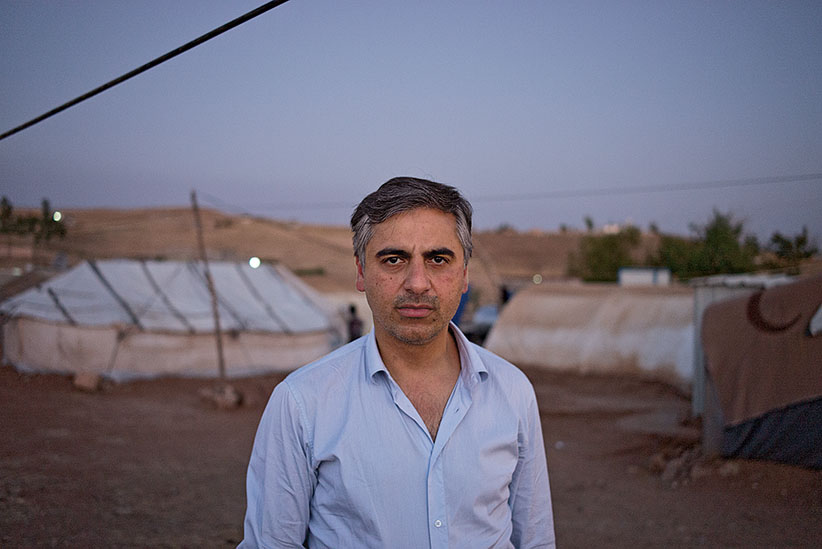
Akhavan sees a “truth commission” as the way forward. Although it is still a work in progress, he says it would be established by the Kurdistan Regional Government with international assistance. It would hear the testimony of survivors, disseminate those truths widely and establish a historical record. It could also include the testimony of perpetrators. That, says Akhavan, could heal the region.
The Yazidi people settled on this land thousands of years ago. They are farmers and shepherds who live unto themselves and practise a religion that goes back to the 12th century, tending their fields of tomatoes and eggplant, herding their sheep. The menace that wrecked their lives on Aug. 3, 2014, is, by their count, the 73rd genocidal attack committed against them since the 1800s, when the Ottomans ruled the area.
Most Yazidis have never heard of the International Criminal Court. The concept of human rights is new to them. But just as surely as night becomes day, they know they have been wronged—severely, tragically. So far they know they are alone in trying to right those wrongs. Everyone has been here—Amnesty International, Human Rights Watch, the UN—but two years after the attack, 450,000 Yazidis are displaced, dead or being used as sex slaves.
Related: Sally Armstrong reports from Iraq on the real faces of ISIS
Hussein Hasoon, a member of the High Government Commission on the Recognition of Genocide Against Yazidis, Kurds and other Religious and Ethnic Groups who will oversee the truth commission, says the Yazidi catastrophe could have been prevented. A Yazidi himself, he was there on that fateful day when ISIS arrived and the people tried to escape by climbing Shingal Mountain. “On Aug. 2 we were living our lives. A few hours later our lives changed forever. We were all on Shingal Mountain [Shingal City was home to three-quarters of the Yazidi population in Iraq] calling everyone, begging them to help us. The international community had time to close the road, to stop the advance of Daesh [a pejorative Arab acronym for ISIS]. They could have created a corridor for us to escape like Moses did at the Dead Sea. We saw the planes and hoped they would use air strikes to open a path for us, but they didn’t.”
“We were in Kocho village when they came,” Zinab says. “We’d heard that people who resisted were punished severely—the men were beheaded and the girls were taken away. So we stayed at the village. They told us to give them our arms. We did, then they said give us your wealth, we did that too.
“We did everything they said to try to stay safe. But then the men and boys over the age of 14 were taken outside the village and shot to death. The older people, including my mother, the boys under seven and the disabled ones, were taken to Shingal. The girls ages 10 to 30 were taken to Mosul; the boys seven to 13 were also taken away. I said I was married to escape going to Mosul but was taken to Tal Afar and kept in a cage. They didn’t know I had a phone hidden in my dress. I called my friend Paraza and she told me my family was safe.
“The first chance I had, I escaped and walked for five days to get to Shingal but was caught again just before getting there. That time I was kept in a house as a slave for a month, then another girl and I got out through a small window. We hid in empty houses for two days and then got to what we thought was a safe house. The Arab family there said, ‘If you are Muslim, we will protect you.’ Then they handed me right back to Daesh. I was shifted to Mosul that time then back to Tal Afar.”
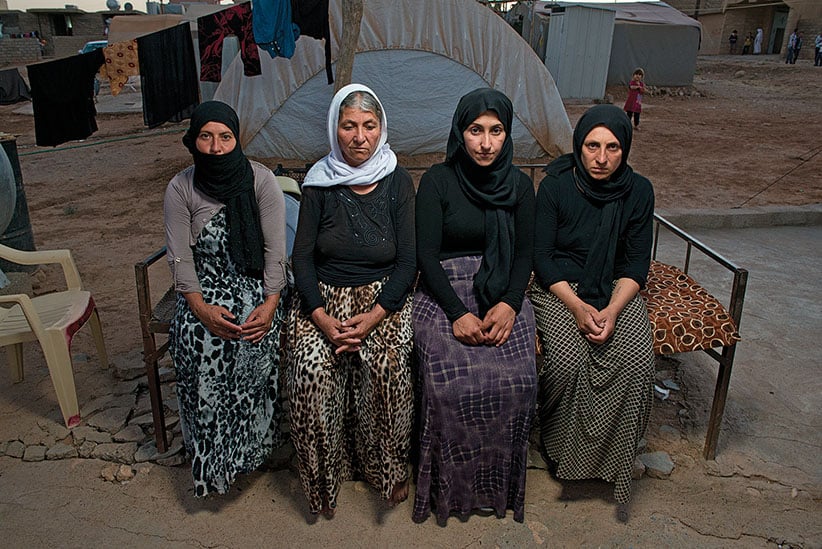
She has black circles under her eyes; her face is as pale as the plaster wall of the house where she sits working over her fingers, clutching her hands and telling her story. “The man who bought me that time beat me badly and raped me whenever he wanted. He made me wash his clothes and clean his house.” She got away again, this time in a taxi—but the driver brought her to his family. His wife told him to kill her. He locked her in a room and the next day sold her to a man in Mosul. “That guy beat me, raped me and kept me in a locked room. Then he sold me to a man in Syria. Half the things that were done to me, I cannot say out loud. By now I was sick, cold and hungry. There was no one to look after me. I didn’t think I could survive much more. Then someone came to the house at 8 o’clock one night and said, ‘Sell this girl to me.’ They did and I was rescued. He’d been sent by my family. We ran as fast as we could and arrived in Shingal at midnight. It was March 22, 2016. I was home.”
Her friend Paraza cannot speak about what happened to her except to say her daughters are still missing. She shows a photo of the girls, hoping someone somewhere has seen them. Zinab’s sister is also missing. They want to raise money to buy them back—but first they need to find them.
Akhavan says a truth commission would educate the people of the region about what really happened here and strip away the innuendo and gossip. “There is a virus of violence spreading in the Middle East that is reaching the rest of the world,” he says. “The attacks have a sameness about them: the seeds of genocidal violence always dehumanize—you can’t kill people you have empathy for.”
Related: The new faces of Afghan women
Hasoon and his committee say they are ready to start that process now. They opened an investigation centre in Dahuk, have a prosecutor, a judge, police officers, a psych-social team and more than 1,000 sworn testimonies from the victims (700 Yazidis, 200 Christians and 150 other religious minorities). Thirty mass graves have been found and are being exhumed. There are bodies all over Shingal Mountain. One of the questions they asked in the survey of victims was, “What do you want?” The vast majority answered, “Justice.” They want a telling, they want the perpetrators punished and the y want the international community to protect them.
While Akhavan feels a truth commission is more expedient and less expensive than a genocide trial, he doesn’t rule out the International Criminal Court in The Hague, especially if a senior ISIS officer can be captured alive. Or the UN Security Council could simply call for a trial. In fact, Canadian Foreign Minister Stéphane Dion wrote to the UN with that very suggestion on May 30. Akhavan says, “Russia will likely veto his request.”
ISIS isn’t the only killer in the region. President al-Assad of Syria has slaughtered 10 times more people than ISIS has. The Shia are also responsible and so is the Shabiha militia. “If there’s to be co-existence, there needs to be an apology and a telling—an acknowledgement of the atrocities,” says Akhavan.
Related: Sally Armstrong in conversation with Canada’s Ambassador to Afghanistan
He barely contains his anger when he speaks of the short-sighted political thinking here in Iraq. “If we continue to indulge dictatorial fanatic regimes, [then] radicalism and terror will get worse. We need to invest not just in bombing, but in creating a culture that allows human rights to take root.”
Genocide is not a natural disaster that comes out of nowhere. It’s a political choice that requires plans and resources, says Akhavan. “There is always an incubation period and plenty of early warning signs, which is when you must act.” ISIS has used social media brilliantly to spread its hateful doctrines and causes: it’s glorious to be a suicide bomber; it’s glorious to rape the daughter of an infidel. “Daesh consider us infidels, so according to their interpretation of the Quran they should kill us and Allah will reward them,” says Hasoon,
The stories are disturbingly similar, as if scripted with a sense of ritualistic, carefully organized and precise extermination. The People of the Book (as Christians and Jews are called) are told to leave. But the Yazidis and anyone else ISIS sees as infidels and not from Abrahamic religions are to be exterminated. They round up the villagers, separate the men and boys from the women and girls. The next selection is separating the young boys and older women and the disabled into another group. Then the men are taken away. Then the young girls are taken. Then the prettiest ones, preferably girls with blue eyes, are selected. It goes on day after day while the Yazidi girls are herded from one town to another.
“One day there will be no Daesh as an organization, but the mind of Daesh will remain in the form of suicide bombers, assassinations, the bombing of places considered to be economic centres,” says Hasoon.
He’s right. Everyone on this file knows it’s easy to get rid of ISIS with military action. But somehow these people need to be able to live together again, and the Yazidis need to know that someone’s got their back this time.
A 14-year-old Yazidi girl, Amira Hussein, has a tattoo on her left forearm that reads, “Bring back my people.” She wears a medallion around her neck with a photo of her missing older brother “so he will always be close to me.” She says she was taken to a place that ISIS calls “Infidel Village” and given to a fighter called Abdullah as a slave. Eight months later she escaped, but says, “If the world cared about us they would have rescued every girl by now. But no one cares.”
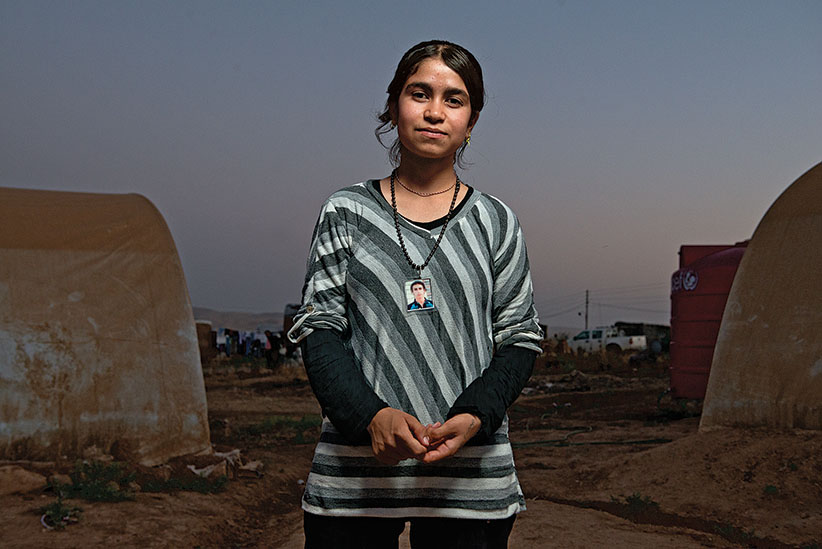
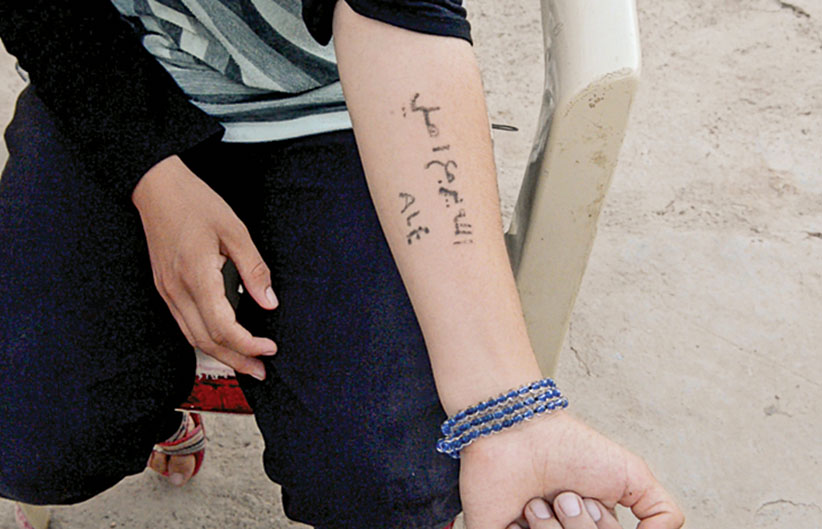
There are several refugee camps scattered on the outskirts of Dahuk, well north of ISIS-controlled areas in Iraq. Every tent has a horror story. It’s dusk when four women gather together and decide to tell theirs: Zatoon, 35, is missing her husband, three daughters and two sons. Gaury, 50, says, “Six of my children are with Daesh, my husband is captured too.” Markaz, 30, says her daughter and husband and 11 family members are being held by ISIS. Nadira, 30, says her older daughter and husband are missing. “I was breastfeeding my three-day-old daughter. They yanked her from me but she cried so hard and so loud they gave her back to me.”
The community in the refugee camp begged in the street to raise money to buy Nadira back from Islamic State. On June 6, she walked into the camp. She hadn’t seen her 12-year-old daughter for almost two years. But her anxiety about the fate of her 10-year-old is palpable. “Imagine what they are doing to her.”
“We’ve had no news in 22 months, we don’t know if our men are dead or alive,” says Markaz. The women look away when they describe what was done to them. “We were made sex slaves in the same house. Whatever is the hardest, toughest thing you can imagine is what they did to us,” says Zatoon. “Anything morally dirty they did it. They took our honour, they took our men and our boys, they raped us and beat us. They took everything from us.”
One night Zatoon, Gaury and Markaz, who were being kept in the same house, decided to run, “We will either die or we will run,” says Markaz. “It was 11 p.m. We opened the door and we ran until we found peshmerga soldiers who brought us here to Dahuk.” Now with achingly sad eyes and raised hands pleading, they speak as one when they say, “Please take our voices to the world, we want our people back.”
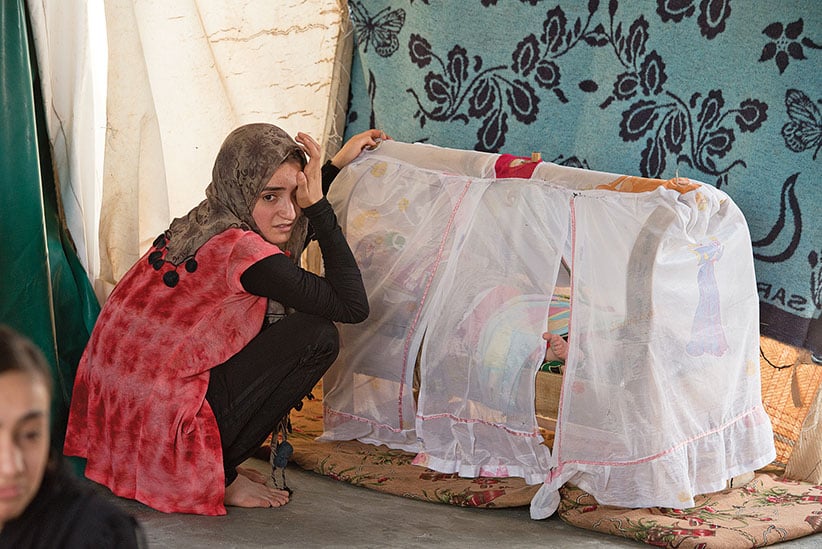
Two months later Beshra and her sister Badia and their cousin were taken to Syria. “There I became a sex slave and was raped by a different fighter every day,” says Beshra. To underscore the sadistic rituals Daesh uses, the girls were brought back home to their parents for two days before being removed again, this time being sold to fighters in two different towns. “The man who bought me is an Iraqi called Arkan,” she says. “His nickname—they all had pseudonyms—was Abu Sarhan. But he lived with 15 men. They raped me and my cousin whenever they wanted to.”
When the men were praying one day, Beshra and her cousin decided to flee. “We told the one left to guard us that we were going to the toilet. It was 5:15 a.m. We crept out of the house and started to run. Whenever we suspected movement, we hid in empty houses and waited for the road to be clear. When we started it was barely light enough for us to see our way. We ran and hid and kept running and hiding until we got to the paved road. Then we hid in the grasses at the side of the road until at last we saw peshmerga soldiers, who took us to Shingal Mountain. By 9 p.m. we were home.”
Her sister Badia, who was also used as a sex slave and managed to escape with the help of a shepherd, describes the ISIS fighters as “dirty, filthy men with huge scraggly beards who are always shouting, always angry, always stinking. They kicked us, raped us, did things to us I cannot describe as I have never heard of them before.”
Her kid sister, Beshra, nods her head when Badia says, “I hope some day I will tell this story in a court, in front of all the world so they will know what those men did to us.”